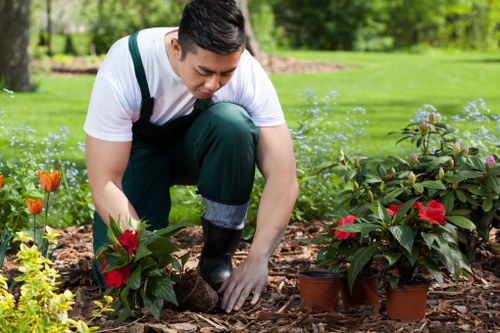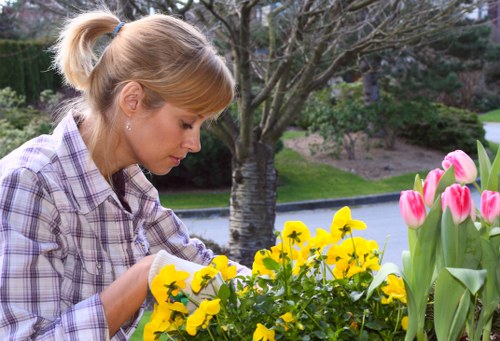Hedge Trimming in Ben Gardening

Introduction to Hedge Trimming
Hedge trimming is an essential aspect of Ben gardening, ensuring your garden remains neat, healthy, and aesthetically pleasing. Proper maintenance not only enhances the visual appeal but also promotes the longevity of your hedges.
Regular trimming helps in controlling the shape and size of your hedges, preventing them from becoming overgrown and unmanageable. It also encourages new growth, ensuring your hedges remain lush and vibrant throughout the year.
In this article, we will delve into the best practices for hedge trimming, the tools you need, and the benefits of maintaining well-trimmed hedges in your Ben garden.

Benefits of Regular Hedge Trimming
Maintaining your hedges through regular trimming offers numerous benefits:
- Enhanced Appearance: Well-trimmed hedges add structure and beauty to your garden.
- Promotes Healthy Growth: Trimming removes dead or diseased branches, allowing healthy parts to thrive.
- Prevents Pests: Regular maintenance reduces the chances of pest infestations.
- Safety: Keeping hedges trimmed can prevent them from obstructing pathways or views.
By investing time in hedge trimming, you ensure your garden remains a serene and inviting space.
Moreover, trimmed hedges can increase the value of your property, making your garden a standout feature.

Essential Tools for Hedge Trimming
Having the right tools is crucial for effective hedge trimming. Here are some essential tools every gardener in Ben should consider:
- Pruning Shears: Ideal for small branches and precise cuts.
- Hedge Trimmers: Electric or manual, these are perfect for larger hedges.
- Loppers: Useful for cutting thick branches that regular shears can't handle.
- Protective Gear: Gloves, safety glasses, and appropriate footwear to ensure safety during trimming.
Investing in high-quality tools can make the trimming process more efficient and enjoyable.
Regular maintenance of your tools will also extend their lifespan and ensure they perform optimally.

Step-by-Step Guide to Trimming Your Hedges
1. Planning Your Trimming Schedule
Before you begin, plan a trimming schedule based on the type of hedge you have. Most hedges benefit from trimming twice a year, typically in spring and late summer.
Consistent scheduling helps maintain the desired shape and prevents excessive growth.
Consider the growth rate of your hedge species to determine the best times for trimming.
2. Preparing Your Tools
Ensure all your tools are clean and sharp. Dull blades can damage the plants and make trimming more difficult.
Disinfect your tools to prevent the spread of diseases between plants.
Regular maintenance of your tools will ensure smooth and efficient trimming.
3. Trimming Technique
Start by removing any dead or diseased branches. This promotes healthy growth and improves the overall appearance of your hedges.
Trim the sides of the hedge uniformly to maintain a consistent shape. Use even strokes for a professional finish.
For taller hedges, consider breaking down the trimming process into manageable sections to avoid fatigue and ensure precision.

4. Maintaining the Shape
Decide on the shape you want for your hedges—whether it's formal, informal, or natural. Consistency is key to achieving a polished look.
Use string lines or guides to help maintain straight edges and uniform angles.
Regularly step back and assess the overall shape, making adjustments as needed to achieve the desired symmetry.
5. Aftercare and Cleanup
After trimming, collect and dispose of all clippings to prevent the spread of pests and diseases.
Inspect your hedges for any signs of stress or damage and address them promptly.
Apply a suitable fertilizer to support new growth and maintain the health of your hedges.
Common Mistakes to Avoid
1. Over-Trimming
While regular trimming is beneficial, over-trimming can stress your plants and inhibit growth.
Always trim in moderation, focusing on shaping rather than removing large sections.
2. Ignoring Plant Health
Failing to remove dead or diseased branches can lead to further deterioration of your hedges.
Regular inspection and maintenance are crucial for the long-term health of your plants.
3. Using Incorrect Tools
Using the wrong tools can damage your hedges and make the trimming process inefficient.
Ensure you have the appropriate tools for the specific tasks involved in hedge trimming.
Choosing the Right Hedge Plants for Your Ben Garden
Selecting the appropriate hedge plants is fundamental to achieving the desired look and functionality in your garden.
Consider factors such as growth rate, maintenance requirements, and resistance to local pests and diseases.
Some popular hedge plants for Ben gardens include boxwood, privet, yew, and laurel.
Boxwood is favored for its dense foliage and ability to maintain intricate shapes.
Privet offers rapid growth and is excellent for creating privacy screens.
Yew is known for its hardiness and can withstand heavy pruning.
Seasonal Hedge Trimming Tips
Spring Trimming
Spring is an ideal time for hedge trimming as it encourages new growth and helps shape your hedges after winter.
Focus on removing any winter damage and shaping the hedges to prepare for the growing season.
Summer Maintenance
During summer, trimming helps keep your hedges from becoming too leggy and maintains their desired height.
Regular watering and mulching complement the trimming process, ensuring healthy growth.
Autumn Preparation
Trim your hedges in autumn to remove any last growth, reducing the risk of damage from winter storms.
This preparation helps your hedges withstand harsh weather conditions and promotes robust growth in the spring.
Winter Protection
While heavy trimming is not recommended in winter, lightly shaping your hedges can help maintain their form.
Protect your hedges from frost by applying mulch and ensuring they are well-watered before cold spells.
Hiring Professional Hedge Trimming Services
While DIY hedge trimming can be rewarding, hiring professionals ensures precision and efficiency.
Professional gardeners have the expertise and tools to handle large or complex hedges, achieving a flawless finish.
Consider the following when choosing a hedge trimming service in Ben:
- Experience and expertise
- Customer reviews and testimonials
- Range of services offered
- Pricing and value for money
Opting for professional services can save you time and ensure your hedges receive the best care possible.
Contact us today to schedule your professional hedge trimming service and transform your garden into a masterpiece.
Conclusion
Hedge trimming is a vital component of maintaining a beautiful and healthy Ben garden. By following best practices, using the right tools, and understanding the needs of your specific hedge plants, you can ensure your hedges remain vibrant and well-shaped throughout the year.
Whether you choose to undertake hedge trimming yourself or hire professionals, consistent maintenance will yield impressive results, enhancing the overall appeal of your garden.
Book your service now and take the first step towards a stunning, well-maintained garden.
- Top Gardening Solutions in Brookfield
- Top-Quality Gardening Solutions in Lilydale
- Top Gardening Solutions in Burwood for a Thriving Garden
- Top-Quality Gardening Solutions in Thornleigh
- Top-Quality Gardening Solutions in Elsternwick
- Top-Quality Gardening Solutions in Mirrabooka
- Transform Your Garden with Expert Services in Woolooware
- Top-Quality Gardening Solutions for Essendon North Residents
- Top Gardening Solutions for Beautiful Outdoor Spaces in Bronte
- Top-Quality Gardening Solutions in Rosebery
- Expert Gardening Solutions in Enfield
- Top Gardening Solutions for Beaumaris and Beyond
- Top Gardening Services in Moorabbin
- Top-Quality Landscaping and Garden Care in Oakleigh
- Top Gardening Solutions in Perth CBD
- Top-Quality Gardening Solutions in Drewvale
- Expert Gardening Solutions in St Peters
- Professional Gardening Solutions in Mortlake
- Top-Quality Gardening Solutions in Kensington
- Top-Quality Gardening Solutions in Bangor
- Transform Your Garden with East Brisbane's Best Services
- Top Gardening Solutions in Doolandella
- Premier Gardening Solutions for Ormond Residents
- Expert Gardening Solutions for Merrylands
- Transform Your Garden with Top Middle Park Gardening Experts
- Top Gardening Solutions in Mindarie
- Transform Your Outdoor Space with North Sydney's Premier Gardening Experts
- Top Gardening Solutions in Kingsley
- Top Gardening Solutions in Clayton South
- Top-Quality Gardening Solutions in Paddington
- Top-Quality Gardening Services in Ascot Vale
- Transform Your Garden with Balmoral’s Expert Gardening Services
- Expert Gardening Solutions in Jindalee
- Premier Gardening Solutions in Clayfield
- Expert Gardening Solutions in and Around Embleton
- Top Gardening Solutions in Brunswick
- Expert Gardening Solutions in Winston Hills
- Top-Quality Landscaping and Garden Care in Vaucluse
- Expert Gardening Solutions in Bossley Park
- Professional Gardening Solutions in Bardia
- Transform Your Outdoor Space with Chippendale's Leading Garden Experts
- Transform Your Garden with Expert Services in Box Hill
- Top Gardening Services in Rowville
- Enhance Your Outdoor Space with Expert Gardening in Avalon Beach
- Top-Quality Gardening Services in Derrimut for a Beautiful Outdoor Space
- Expert Gardening Solutions for a Thriving Forrestfield
- Expert Gardening Solutions for Kirribilli Residents
- Top Gardening Solutions in Stirling and Surrounding Areas
- Top Gardening Solutions in Eight Mile Plains
- Transform Your Garden with Top Gardening Services in Brighton East
